Compost guide
compost: reduce food waste
Enrich your soil naturally, prevent erosion, conserve water, close the loop, save money, and fight global warming by practicing composting!
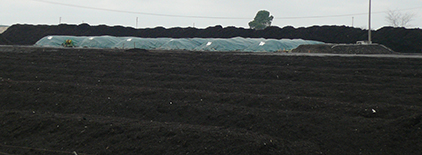
why make compost?
Compost is one of nature's best mulches and soil amendments, and you can use it instead of commercial fertilizers. Best of all, compost is cheap.
You can make it without spending a cent. Using compost improves soil structure, texture, and aeration and increases the soil's water-holding capacity. Compost loosens clay soils and helps sandy soils retain water. Adding compost improves soil fertility and stimulates healthy root development in plants.
The organic matter provided in compost provides food for microorganisms, which keeps the soil in a healthy, balanced condition. Nitrogen, potassium, and phosphorus will be produced naturally by the feeding of microorganisms, so few if any soil amendments will need to be added.
Most gardeners have long understood the value of this rich, dark, earthy material in improving the soil and creating a healthful environment for plants. Understanding how to make and use compost is in the public interest, as the problem of waste disposal climbs toward a crisis level. Landfills are brimming, and new sites are not likely to be easily found. For this reason there is an interest in conserving existing landfill space and in developing alternative methods of dealing with waste. Don't throw away materials when you can use them to improve your lawn and garden! Start composting instead.
About one third of the space in landfills is taken up with organic waste from our yards and kitchens, just the type of material that can be used in compost. With a small investment in time, you can contribute to the solution to a community problem, while at the same time enriching the soil and improving the health of the plants on your property.
The compost decomposition process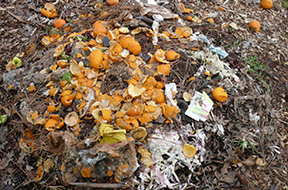
Compost is the end product of a complex feeding pattern involving hundreds of different organisms, including bacteria, fungi, worms, and insects. What remains after these organisms break down organic materials is the rich, earthy substance your garden will love. Composting replicates nature's natural system of breaking down materials on the forest floor. In every forest, grassland, jungle, and garden, plants die, fall to the ground, and decay. They are slowly dismantled by the small organisms living in the soil. Eventually these plant parts disappear into the brown crumbly forest floor. This humus keeps the soil light and fluffy.
Humus is our goal when we start composting. By providing the right environment for the organisms in the compost pile, it is possible to produce excellent compost. We usually want to organize and hasten Mother Nature's process. By knowing the optimum conditions of heat, moisture, air, and materials, we can speed up the composting process. Besides producing more good soil faster, making the compost faster creates heat which will destroy plant diseases and weed seeds in the pile.
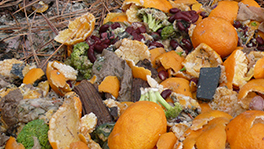 Compost Materials
Compost Materials
Almost any organic material is suitable for a compost pile. The pile needs a proper ratio of carbon-rich materials, or "browns," and nitrogen-rich materials, or "greens." Among the brown materials are dried leaves, straw, and wood chips. Nitrogen materials are fresh or green, such as grass clippings and kitchen scraps.
Mixing certain types of materials or changing the proportions can make a difference in the rate of decomposition. Achieving the best mix is more an art gained through experience than an exact science. The ideal ratio approaches 25 parts browns to 1 part greens. Judge the amounts roughly equal by weight. Too much carbon will cause the pile to break down too slowly, while too much nitrogen can cause odor. The carbon provides energy for the microbes, and the nitrogen provides protein.
Leaves represent a large percentage of total yard waste. If you can grind them in a gas or electric chipper shredder or mow over them, they will reduce in size making them easier to store until you can use them in the pile, and they will decompose faster - an issue with larger leaves. They are loaded with minerals brought up from the tree roots and are a natural source of carbon. A few leaf species such as live oak, southern magnolia, and holly trees are too tough and leathery for easy composting. Avoid all parts of the black walnut tree as they contain a plant poison that survives composting. Eucalyptus leaves can be toxic to other plants. And avoid using poison oak, poison ivy, and sumac.
Pine Needles need to be chopped or shredded, as they decompose slowly. They are covered with a thick, waxy coating. In very large quantities, they can acidify your compost, which would be a good thing if you have alkaline soils.
Grass Clippings break down quickly and contain as much nitrogen as manure. Since fresh grass clippings will clump together, become anaerobic, and start to smell, mix them with plenty of brown material. If you have a lot of grass clippings to compost, spread them on the driveway or other surface to bake in the sun for at least a day. Once it begins to turn pale or straw-like, it can be used without danger of souring. Avoid grass clippings that contain pesticide or herbicide residue, unless a steady rain has washed the residue from the grass blades.
Kitchen Refuse includes melon rinds, carrot peelings, tea bags, apple cores, and banana peels - almost everything that cycles through your kitchen. The average household produces more than 200 pounds of kitchen waste every year. You can successfully compost all forms of kitchen waste. However, meat, meat products, dairy products, and high-fat foods like salad dressings and peanut butter, can present problems. Meat scraps and the rest will decompose eventually, but will smell bad and attract pests. Egg shells are a wonderful addition, but decompose slowly, so should be crushed. All additions to the compost pile will decompose more quickly if they are chopped up some before adding.
To collect your kitchen waste, you can keep a small compost pail in the kitchen to bring to the pile every few days. Keep a lid on the container to discourage insects. When you add kitchen scraps to the compost pile, cover them with about 8" of brown material to reduce visits by flies or critters.
Wood Ashes from a wood burning stove or fireplace can be added to the compost pile. Ashes are alkaline, so add no more than 2 gallon-sized buckets-full to a pile with 3'x3'x3' dimensions. They are especially high in potassium. Don't use coal ashes, as they usually contain large amounts of sulfur and iron that can injure your plants. Used charcoal briquettes don't decay much at all, so it's best not to use them.
Garden Refuse should make the trip to the pile. All of the spent plants, thinned seedlings, and deadheaded flowers can be included. Most weeds and weed seeds are killed when the pile reaches an internal temperature above 130 degrees, but some may survive. To avoid problems don't compost weeds with persistent root systems, and weeds that are going to seed.
Spoiled Hay or Straw makes an excellent carbon base for a compost pile, especially in a place where few leaves are available. Hay contains more nitrogen than straw. They may contain weed seeds, so the pile must have a high interior temperature. The straw's little tubes will also keep the pile breathing.
Manure is one of the finest materials you can add to any compost pile. It contains large amounts of both nitrogen and beneficial microbes. Manure for composting can come from bats, sheep, ducks, pigs, goats, cows, pigeons, and any other vegetarian animal. As a rule of thumb, you should avoid manure from carnivores, as it can contain dangerous pathogens. Most manures are considered "hot" when fresh, meaning it is so rich in nutrients that it can burn the tender roots of young plants or overheat a compost pile, killing off earthworms and friendly bacteria. If left to age a little, however, these materials are fine to use.
Seaweed is an excellent source of nutrient-rich composting material. Use the hose to wash off the salt before sending it to the compost pile.
The list of organic materials which can be added to the compost pile is long. There are industrial and commercial waste products you may have access to in abundance. The following is a partial list: corncobs, cotton waste, restaurant or farmer's market scraps, grapevine waste, sawdust, greens, hair, hoof and horn meal, hops, peanut shells, paper and cardboard, rock dust, sawdust, feathers, cottonseed meal, blood meal, bone meal, citrus wastes, coffee, alfalfa, and ground seashells.
Chart of common composting material
Type of Material |
Use it ? |
Carbon / Nitrogen |
Details |
| Algae, seaweed and lake moss | Yes |
N |
Good nutrient source. |
| Ashes from coal or charcoal | No |
n/a |
May contain materials bad for plants. |
| Ashes from untreated, unpainted wood | Careful |
Neutral |
Fine amounts at most. Can make the pile too alkaline and suppress composting. |
| Beverages, kitchen rinse water | Yes |
Neutral |
Good to moisten the middle of the pile. Don't over-moisten the pile. |
| Bird droppings | Careful |
N |
May contain weed seeds or disease organisms. |
| Cardboard | Yes |
C |
Shred into small pieces if you use it. Wetting it makes it easier to tear. If you have a lot, consider recycling instead. |
| Cat droppings or cat litter | No |
n/a |
May contain disease organisms. Avoid all carnivore droppings. |
| Coffee ground and filters | Yes |
N |
Worms love coffee grounds and coffee filters. |
| Cornstalks, corn cobs | Yes |
C |
Best if shredded and mixed well with nitrogen rich materials. |
| Diseased plants | Careful |
N |
If your pile doesn't get hot enough, it might not kill the organisms, so be careful. Let it cure several months, and don't use resulting compost near the type of plant that was diseased. |
| Dryer lint | Yes |
C |
Compost away! Moistening helps. |
| Eggshells | Yes |
C |
Break down slowly. Crushing shells helps. |
| Fish scraps | No |
n/a |
Can attract rodents and cause a stinky pile. Best to dig a hole and simple bury them. |
| Hair | Yes |
N |
Scatter so it isn't in clumps. |
| Lime | No |
n/a |
Can kill composting action. Avoid. |
| Manure (horse, cow, pig, sheep, goat, chicken, rabbit) | Yes |
N |
Great source of nitrogen. Mix with carbon rich materials so it breaks down better. |
| Meat, fat, grease, oils, bones | No |
n/a |
Avoid. Can attract pests etc. |
| Milk, cheese, yogurt | Careful |
Neutral |
Put it deep in the pile to avoid attracting animals. |
| Newspaper | Yes |
C |
Shred it so it breaks down easier. It is easy to add too much newspaper, so recycle instead if you have a lot. Don't add slick colored pages. |
| Oak leaves | Yes |
C |
Shredding leaves helps them break down faster. They decompose slowly. Acidic. |
| Sawdust and wood shavings (untreated wood) | Yes |
C |
You'll need a lot of nitrogen materials to make up for the high carbon content. Don't use too much, and don't use treated woods. |
| Pine needles and cones | Yes |
C |
Don't overload the pile. Also acidic and decomposes slowly. |
| Weeds | Careful |
N |
Dry them out on the pavement, and then add later. |
| Sod | Careful |
N |
Make sure the pile is hot enough, so grass doesn't continue growing. |
Compost site selection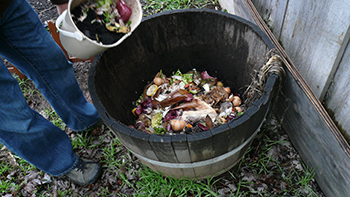

Any pile of organic matter will eventually rot, but a well-chosen site can speed up the process. Look for a level, well-drained area. If you plan to add kitchen scraps, keep it accessible to the back door. Don't put it so far away you'll neglect the pile. In cooler latitudes, keep the pile in a sunny spot to trap solar heat. Look for some shelter to protect the pile from freezing cold winds which could slow down the decaying process.
In warm, dry latitudes, shelter the pile in a shadier spot so it doesn't dry out too quickly. Build the pile over soil or lawn rather than concrete or asphalt, to take advantage of the earthworms, beneficial microbes, and other decomposers, which will migrate up and down as the seasons change. Uncovered soil also allows for drainage. If tree roots are extending their roots into the pile, turn it frequently so they can't make headway. Look for a spot that allows you to compost discretely, especially if you have neighboring yards in close proximity. Aim for distance and visual barriers between the pile and the neighbors.
Seasonal composting
An effective storage system is the key to successfully using the materials each season provides. In the fall, collect and shred fallen leaves. The best use for them now is as mulch for trees, shrubs, and garden beds. Excess leaves can be stored - leaves from 100 bags can be shredded and put in a 4'x4'x4' container. Some decomposition will take place over the winter, but not a significant amount. Continue to put kitchen scraps in the pile, but it's not necessary to turn in cold climes. If you want your compost pile to stay active during the winter, you'll want an enclosed bin with insulated sides. A black bin situated in a sunny spot can help trap solar radiation during cold spells. Keep the pile as large as possible so that heat generated from decomposition will endure. You can also stack bales of straw along the sides of your bin to help retain the heat.
In areas with a cold winter, spring is the best time to start the compost pile in earnest. There's an abundance of grass clippings and trimmings. Summer is the time the compost pile is working at its peak range of decomposition, especially if it has been turned once or twice. Cover and store the finished compost, or use it, and start another batch. With enough organic waste, you can produce several batches of highly managed compost during the summer.
making compost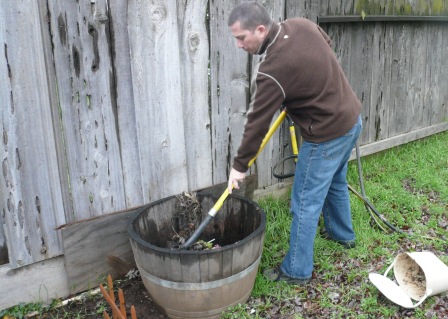

Compost can range from passive - allowing the materials to sit and rot on their own - to highly managed. Whenever you intervene in the process, you're managing the compost. How you compost is determined by your goal. If you're eager to produce as much compost as possible to use regularly in your garden, you may opt for a more hands-on method of composting. If your goal is to dispose of yard waste, a passive method is your answer.
Passive composting involves the least amount of time and energy on your part. This is done by collecting organic materials in a freestanding pile. It might take a long time (a year or two), but eventually organic materials in any type of a pile will break down into finished compost. More attractive than a big pile of materials sitting in your yard is a 3-sided enclosure made of fencing, wire, or concrete blocks, which keeps the pile neater and less unsightly. Add grass clippings, leaves, and kitchen scraps (always cover these with 8" of other material). The pile will shrink quickly as the materials compress and decompose. Wait a year or two before checking the bottom of the bin for finished compost. When it's ready, shovel the bottom section into a wheelbarrow and add it to your garden beds. Continue to add greens and browns to have a good supply of finished compost at the ready. After the first few years, most simple piles produce a few cubic feet of finished compost yearly.
Managed composting involves active participation, ranging from turning the pile occasionally to a major commitment of time and energy. If you use all the techniques of managing the pile, you can get finished compost in 3-4 weeks. Choose the techniques that reflect how much you want to intervene in the decomposition process and that will be a function of how fast you want to produce compost.
The speed with which you produce finished compost will be determined by how you collect materials, whether you chop them up, how you mix them together, and so on. Achieving a good balance of carbon and nitrogen is easier if you build the pile all at once. Layering is traditional, but mixing the materials works as well.
Shredded organic materials heat up rapidly, decompose quickly, and produce a uniform compost. The decomposition rate increases with the size of the composting materials. If you want the pile to decay faster, chop up large fibrous materials.
You can add new materials on an ongoing basis to an already established pile. Most single-bin gardeners build an initial pile and add more ingredients on top as they become available.
The temperature of the managed pile is important - it indicates the activity of the decomposition process. The easiest way to track the temperature inside the pile is by feeling it. If it is warm or hot, everything is fine. If it is the same temperature as the outside air, the microbial activity has slowed down and you need to add more nitrogen (green) materials such as grass clippings, kitchen waste, or manure.Use a compost thermometer to easily see how well your compost is doing. They are inexpensive, and quite convenient to have.
If the pile becomes too dry, the decay process will slow down. Organic waste needs water to decompose. The rule of thumb is to keep the pile as moist as a wrung-out sponge.If you're building your pile with very wet materials, mix them with dry materials as you build. If all the material is very dry, soak it with a hose as you build. Whenever you turn the pile, check it for moisture and add water as necessary.
Too much water is just as detrimental as the lack of water. In an overly wet pile, water replaces the air, creating an anaerobic environment, slowing decomposition.
Air circulation is an important element in a compost pile. Most of the organisms that decompose organic matter are aerobic - they need air to survive. There are several ways to keep your pile breathing. Try not to use materials that are easily compacted such as ashes or sawdust, without mixing them with a coarser material first. People who build large piles often add tree branches or even ventilation tubes vertically into different parts of the pile, to be shaken occasionally, to maximize air circulation.
A more labor-intensive way to re-oxygenate the pile is to turn the pile by hand, using a large garden fork. The simplest way is to move the material from the pile and re- stack it alongside. A multiple-bin system makes this efficient, in that you only handle the material once. Otherwise, you can put the material back into the same pile. The object is to end up with the material that was on the outside of the original pile, resting in the middle of the re- stacked pile. This procedure aerates the pile and will promote uniform decomposition.
The following information is for the highly managed pile and the optimum finished compost in the shortest amount of time. Decomposition occurs most efficiently when the temperature inside the pile is between 104 degrees F and 131 degrees F. Compost thermometers are available at garden shops and nurseries. It is best not to turn the pile while it is between these temperatures, but rather when the temperature is below 104 degrees F or above 131 degrees F. This keeps the pile operating at its peak. Most disease pathogens die when exposed to 131 degrees for 10-15 minutes, though some weed seeds are killed only when they're heated to between 140 degrees and 150 degrees. If weed seeds are a problem, let the pile reach 150 degrees during the first heating period, then drop back down to the original temperature range. Maintaining temperatures above 131 degrees can kill the decomposing microbes.
compost bins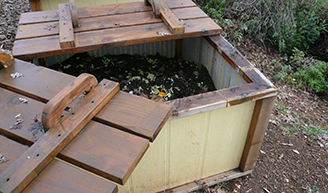

To save space, hasten decomposition, and keep the yard looking neat, contain the compost in some sort of structure. A wide variety of composting structures can be purchased, or made from a variety of materials. They can be as simple or complex as desired.
Yard wastes can be composted either in a simple holding unit, where they will sit undisturbed for slow decomposition, or in tumbling compost bins, which produce finished compost as quickly as just a few weeks with a good mix of materials.
Holding units are simple containers used to store garden waste in an organized way until these materials break down. A holding unit is the easiest way to compost. It only requires placing wastes into a pile or bin as they are generated. Non-woody materials such as grass clippings, crop wastes, garden weeds, and leaves work best in these systems. A holding unit can be a cylinder formed of wire (chicken wire is too weak to hold up to the bulk), or wood scraps. Openings in the sides need to be large enough to permit plenty of air, but small enough to contain the materials that are composting.
Turning units are typically a series of bins used for building and turning active compost piles. A turning unit allows wastes to be conveniently mixed for aeration on a regular basis.
Home gardeners are constantly inventing creative and inexpensive ways to hold their compost - for example, bins made from wire mesh or from shipping pallets.
Some gardeners lash together four pallets, leaving one corner loosely attached to act as a door. Others install posts in four corners, nail the pallets to the posts to form three sides of the bin, and wire the last pallet with some slack to allow access.
Make a simple, three-sided bin by stacking concrete or cinder blocks. Leave the fourth side open for turning the pile or for access to the finished compost.
Renewed interest in recycling has prompted a great increase in the types of composting systems available commercially. Consider the advantages and disadvantages of each type of compost bin to choose the best one for your yard, budget, and life-style. They range from wire containers to plastic bins and tumblers.
vermicompost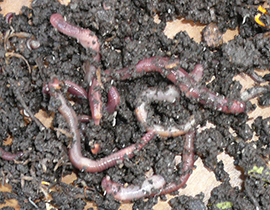

Vermicomposting, or worm composting, is different than traditional composting. Worm composting is a process that uses red earthworms, also commonly called redworms, to consume organic waste, producing castings (an odor-free compost product for use as mulch), soil conditioner, and topsoil additive. Naturally occurring organisms, such as bacteria and millipedes, also assist in the aerobic degradation of the organic material. Commercially available worm composting bins make it fairly simple to do your own vermicomposting indoors.
Vermicomposting is especially useful for processing food scraps, since the worms consume the material quickly and there are fewer problems with odor. Worm composting does not generate temperatures high enough to kill pathogens. For this reason, vermicomposting is more appropriate for food, paper, and yard waste.
Food scraps should be chopped or shredded for faster degradation. Unprocessed materials can be used in vermicomposting, but the time required for complete degradation of the organic waste is generally six months or longer. Vermicomposting does not require a specific carbon-to-nitrogen ratio like traditional aerobic composting methods.
Trouble shooting
| Damp and warm only in the middle of the pile. | Pile could be too small, or cold weather might have slowed composting | If you are only composting in piles, make sure your pile is at least 3 feet high and 3 feet wide. With a bin, the pile doesn't need to be so large. |
| Nothing is happening.Pile doesn't seem to be heating up at all. | 1. Not enough nitrogen 2. Not enough oxygen 3. Not enough moisture 4. Cold weather? 5. Compost is finished. |
1. Make sure you have enough nitrogen rich sources like manure, grass clippings or food scraps. 2. Mix up the pile so it can breathe. 3. Mix up the pile and water it with the hose so that there is some moisture in the pile. A completely dry pile doesn't compost. 4. Wait for spring, cover the pile, or use a bin. |
| Matted leaves or grass clippings aren't decomposing. | Poor aeration or lack of moisture. | Avoid thick layers of just one material. Too much of something like leaves, paper or grass clippings don't break down well. Break up the layers and mix up the pile so that there is a good mix of materials. Shred any big material that isn't breaking down well. |
| Stinks like rancid butter, vinegar or rotten eggs. | Not enough oxygen or the pile is too wet, or compacted. | Mix up the pile so that it gets some aeration and can breathe. Add course dry materials like straw, hay or leaves to soak up excess moisture. If smell is too bad, add dry materials on top and wait until it dries out a bit before you mix the pile. |
| Odor like ammonia. | Not enough carbon. | Add brown materials like leaves, straw, hay, shredded newspaper, etc. |
| Attracts rodents, flies, or other animals. | Inappropriate materials (like meat, oil, bones), or the food-like material is too close to the surface of the pile. | Bury kitchen scraps near the center of the pile. Don't add inappropriate materials to compost. Switch to a rodent-proof closed bin. |
| Attracts insects, millipedes, slugs, etc. | This is normal composting, and part of the natural process. | Not a problem. |
| Fire ant problems. | Pile could be too dry, not hot enough, or has kitchen scraps too close to the surface. | Make sure your pile has a good mix of materials to heat up, and keep it moist enough. |
 Using compost
Using compost
Finished compost is dark brown, crumbly, and is earthy-smelling. Small pieces of leaves or other ingredients may be visible. If the compost contains many materials which are not broken down, it is only partly decomposed. This product can be used as a mulch, but adding partly decomposed compost to the soil can reduce the amount of nitrogen available to the plants. The microorganisms will continue to do the work of decomposing, but will use soil nitrogen for their own growth, restricting the nitrogen's availability to plants growing nearby.
Allow partly decomposed compost particles to break down further or separate them out before using compost on growing plants. Or add extra nitrogen such as manure, to ensure that growing plants will not suffer from a nitrogen deficiency. Compost is great for flower gardening, herb gardening, organic lawn care and vegetable gardening.
Compost serves primarily as a soil conditioner, whether it's spread in a layer on the soil surface or is dug in. A garden soil regularly amended with compost is better able to hold air and water, drains more efficiently, and contains a nutrient reserve that plants can draw on. The amended soil also tends to produce plants with fewer insect and disease problems. The compost encourages a larger population of beneficial soil microorganisms, which control harmful microorganisms. It also fosters healthy plant growth, and healthy plants are better able to resist pests.
One inch thick is enough to spread on your garden beds. Compost continues to decompose, so eventually the percentage of organic matter in the soil begins to decline. In northern climates, compost is mostly decomposed after two years in the soil. In southern climates, it disappears even faster and should be replenished every year.
To bolster poor soil with little organic matter, spread 2 to 3 inches of compost over a newly dug surface. Then work the compost into the top 6 inches of earth.
A garden soil that has been well mulched and amended periodically requires only about a ½ inch layer of compost yearly to maintain its quality.Some people recommend late fall as a good time to spread compost over a garden bed, and cover it with a winter mulch, such as chopped leaves. By spring, soil organisms will have worked the compost into the soil. Others recommend spreading compost two weeks before planting time in the spring. There is really no wrong time to spread it. The benefits remain the same.
If your supply of compost is really limited, consider side-dressing, a way to use compost sparingly by strategically placing it around certain plants or along certain rows. This is best done in late spring and early summer so that the rapidly growing plants can derive the maximum benefit from the compost.
To side-dress a plant, work the compost into the soil around the plant, starting about an inch from the stem, out to the drip line, taking care not to disturb the roots. For shallow rooted plants, leave the compost on the soil surface. A 2" layer works best when left on top.
For new lawns, a 2 to 3" layer of compost is best when planting. Once the new lawn is established, a ¼ to ½" layer yearly will maintain the quality of the soil.
An existing lawn top-dressed with a ½" layer of compost every year or two will be healthier than an unamended lawn. Fall is the best time to apply the compost, although an application in early spring is almost as effective.
Compost mulch can benefit trees and shrubs just as it does other plants. Spread a ½" to 1" layer of compost on the bare soil under the tree as far as the drip line. Then cover with a 2-3" layer of some other kind of organic mulch, such as chopped leaves or pine needles. The mulch will hold the compost in place and keep it from drying out.
Adding compost to the planting hole of small perennial plants is valuable, particularly perennial food plants. Annuals will also benefit from a dose of compost at planting time.
Compost is the ultimate garden fertilizer. It contains virtually all the nutrients a living plant needs and delivers them in a slow-release manner over a period of years. Compost made with a wide variety of ingredients will provide an even more nutritious meal to your growing plants.
Compost is the best material available to enliven your soil no matter where you live. Farmers around the world will testify that healthier soil grows healthier plants that naturally resist disease, insects, and other environmental pressures. Adding compost to your garden is a long-term investment - it becomes a permanent part of the soil structure, helping to feed future plantings in years to come.
Buying Compost
Below is a list of links for local businesses that sell various forms of compost. You will also find various forms of compost for sale in bulk at any of your local garden centers. However, the two links below make their compost onsite locally.
The Worm Farm: 9033 Esquon Road, Durham (530) 894-1276
The Earthworm Soil Factory: 2552 Clark Rd, Butte Valley, CA 95965 (530)-895-9676
Valley Gold Compost: 4398 County Road S, Orland, CA 95963-9819 (530) 865-1320
Compost Solutions Inc: 4446 County Road N, Orland, CA 95963-9809 (530) 865-2993
